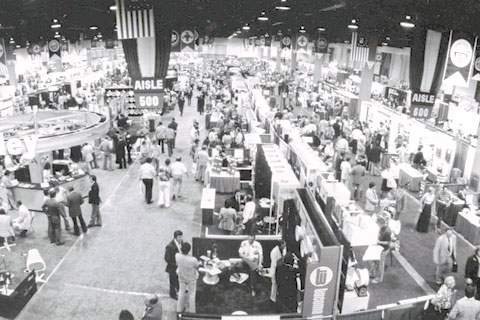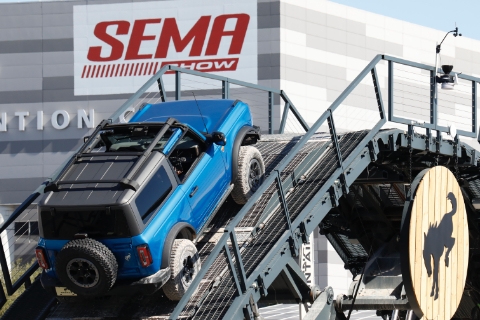SEMA News—August 2019
PEOPLE
2019 SEMA Hall of Fame
Honoring Bob Chandler, Bruce Crower and Marla Moore
By Matthew Pearson
This year’s SEMA Hall of Fame inductees are all very different people, with unique paths to success, but all three have certain qualities in common. They have inspired innovation, fostered collaboration and, most importantly, created opportunities for others. Though their careers have taken markedly different paths, each has demonstrated persistence, generosity and enthusiasm. And each of this year’s inductees leave a continuing endowment through the companies they built, the service they provided, and the people they influenced—legacies that will continue to benefit the industry for a long time to come.
The class of 2019 will officially be welcomed into the Hall of Fame at the Installation & Gala on July 26, and they will also be honored at the Industry Awards Banquet during the SEMA Show.
Here are their inspiring stories.
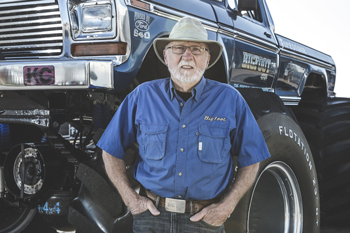 |
Bob Chandler
Invented the Monster Truck Sport
Hard as it may be to believe, one the most popular segments of motorsports enjoyed around the world came about purely by accident. Meet Bob Chandler. For those who may not recognize his name, you most certainly have been exposed to his work. He has been in the industry for more than 45 years and is credited with inventing the monster truck sport.
Chandler grew up in St. Louis prior to moving to California, where he joined the Navy right out of high school and served as an engineman on a minesweeper. He returned to St. Louis and his family business as a carpenter, and then he met Marilyn, his wife of 54 years.
Early in their marriage, the couple had a four-wheel drive that they drove to Alaska and back. They lived in it for three months, camping out of the back.
“We went through California, and they were starting to get four-wheel drives with bigger tires and rollbars and lights,” Chandler said. “I knew this was something that’s going to come back to
the Midwest.”
In 1973, Chandler was involved in a motorcycle accident that all but ended his future as a carpenter.
“That’s what actually got me into this business,” Chandler said. “I had an accident, got pretty well banged up. I knew I couldn’t go back to construction work, so I opened a four-wheel-drive shop.”
Chandler ordered a new ’74 Ford F-250 to highlight the products Midwest 4 Wheel Drive sold. When the pickup came in, he drove the 5 mi. to the Chandlers’ house and immediately put bigger tires and wheels on it in their garage, which had been turned into the Midwest 4 Wheel Drive Center. Then he hit
the road.
“We put all these parts on the truck, and we would go out to events,” he said. “I always wanted to be ahead of everybody else, so I’d make it look bigger. And when you put bigger tires on, then you need bigger axles, because you break axles. And when you get bigger axles with these bigger tires, then you don’t have enough power, so you put a bigger engine in it. And then later on, you end up with even bigger tires, and you’ve got to go through the whole process again.”
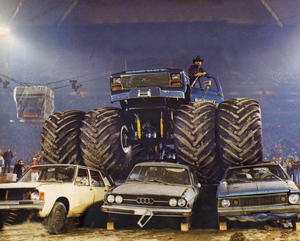 |
The truck got its name from Chandler’s lead-foot tendencies.
“I’d come back on Monday morning with something broken on the truck, and my general manager started calling me Bigfoot, because I couldn’t keep my foot off the throttle,” Chandler said. “I liked the name, so I put it on the side of the truck, and it stuck.”
In 1977, Chandler and his wife drove Bigfoot to the SEMA Show, beginning a tradition that has included a truck on display nearly every year since—with that number growing to as many as five trucks one year.
A car show in Denver was the site of Bigfoot’s first paid performance. Prior to that, Chandler was only attending local events.
“There were no sponsors early on, of course,” he said. “It just slowly grew after that.”
Chandler’s inspiration for his next challenge came from a TV show that featured cars messing around in a junkyard. He suggested to a friend that Bigfoot would be able to drive over those cars. So they got four junk cars in a farmer’s field and proceeded to videotape the trial run.
A promoter saw the video and wanted him to do the stunt in front of a crowd. When he did, Chandler said he was shocked by how crazy people went for it.
Racing seemed to follow as a next step, since the promoters were always looking for something new.
“Every year, we would do something more,” Chandler said. “It eventually got to the point where my partner in this business, Jim Kramer—the vice president of the company—started racing the vehicles more than anybody else. He actually brought the industry from where it was to what it is today and made a motorsport out of it.”
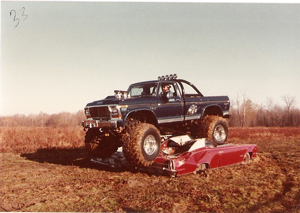 |
Chandler co-founded the Monster Truck Racing Association (MTRA) along with George Carpenter to promote safety in the industry. The two were also instrumental in the development of the first remote ignition interrupter, which was designed to shut down a vehicle remotely if necessary. The current rule in monster truck racing is that you don’t drive your truck at more than an idle without somebody being there with a switch.
When asked about the future of monster trucks, Chandler responded: “Well, we’re not slowing up at all. We’ve been in 26 countries with Bigfoot. We’ve got a truck in Hawaii right now. We’ve had a truck stationed in Australia and one stationed in England for several years. But the industry just seems to keep going and keeps coming with new things every year.”
On his induction to the SEMA Hall of Fame Chandler said: “I’ve gone down the list of people who are in there already, and I don’t know if I belong there. Some neat names out there—Mickey Thompson, Bill Stroppe, Thurston Warn, Dick Cepek, Vic Edelbrock, Keith Black and Bob Hedman…just on and on and on. These are people who I looked up to for years. I still do. Anyway, it’s amazing, and I’m very thankful to the people who were involved in getting me in.”
In addition to the SEMA Hall of Fame, Chandler has been recognized by the Missouri Sports Hall of Fame, the Off-Road Motorsports Hall of Fame and the International Monster Truck Museum Hall of Fame, and he was presented with the MTRA Bob Chandler Award for Safety.
“They say there wouldn’t be monster trucks if it wasn’t for me, but my thought is that it was going to happen anyway,” Chandler said. “Because things work in cycles, it was something that would have happened to somebody else. But I was very lucky that it came my way first.”
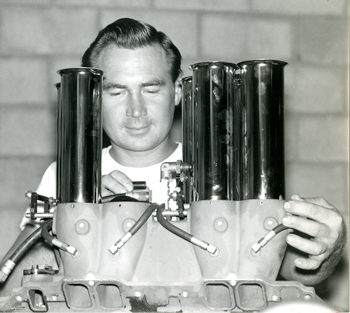 |
Bruce Crower
A Force for Innovation
As part of the formal process of nominating an individual for the SEMA Hall of Fame, it’s required to explain how the industry would be different today had it not been for the nominee’s involvement. In the case of Bruce Crower, his peers offer that “Bruce Crower has been one of the greatest innovators of performance parts in the history of the industry,” and “Bruce has been an unmatched innovator of all things motorsports.”
“The speed and safety of drag racing today would never have reached the heights it has without Bruce,” said another, and “There is no part of the industry not touched by Bruce Crower’s innovations.”
More than 60 years ago, Crower began making performance parts for himself and his fellow hot rodders. Today, his passion to make things go faster has resulted in a multimillion-dollar organization that produces high-performance aftermarket parts for a wide variety of applications, including cars, trucks, motorcycles, tractors and antiques. A detailed history as well as recollections from Crower were used to develop this profile and can be found on the company’s website.
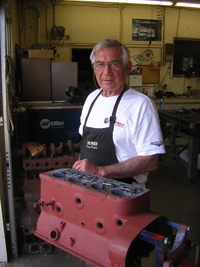 |
“In those days, there were lots of fix-it-yourself people, a carryover from the depression,” Crower recalled. “I was no different. I really did melt down old aluminum pistons to form castings in Maxwell House coffee cans. Then I machined the grooves for the pulleys necessary for the five-belt drive.”
“Money was scarce, but machine shops and junkyards were plenty. I kept my eyes and ears open, always thinking, ‘How can I use this old part to better serve the speed game?’ I began modifying and machining parts in the 40s in my early teens. When I was 13, I got a Moto-Scoot with a small 5hp/8hp Briggs & Stratton. There wasn’t much that could be done to add speed to it, but the engine was reliable and I did modify it a bit to get the most out of it. Before long I was buying up motor scooters and fixing them to sell to returning
World War II veterans who needed inexpensive transportation.”
At 17, Crower picked up a like-new 74ci Harley-Davidson motorcycle. In short order, he raised its compression, which resulted in higher speeds and better fuel economy. His first car was a ’36 Ford coupe that he bought from a friend for $115. It was while he was in high school that Crower realized that his self-made parts were in demand, so he decided to start making one part for himself and a few extra to sell to his fellow racing enthusiasts.
“I’d also started making some money modifying engines for some of the local races, so I opened Bruce Crower Automotive Service in Phoenix,” he said. “I was doing business for about a year when I received a draft notice. With that encouragement, I quickly enlisted in the Air Force, learning additional skills in Uncle Sam’s machine shop. Upon my discharge in 1952, I headed to San Diego, where hot rodding was flourishing.”
In San Diego, he picked up a job as a machinist at Paul Schiefer Clutches.
“As I got more and more requests for making or modifying parts, I opened a small machine shop and got serious in the aftermarket racing parts business,” he said.
That was 1955. With $312 in the bank, Crower bought a sixth-page ad in Hot Rod for $300. According to Crower, the ad generated more than $10,000 in orders. He was controlling his destiny, and the harder he worked, the more money he made. He would work until the early morning and he was so busy that he hired his brother Dave, his sister Linda and later his brother-in-law Loren, to keep up with demand.
“Crower Racing Cams & Equipment Company is now located in San Diego in a 100,000 sq.-ft. building and employs around 100 people,” Crower said. “The coffee cans and borrowed time on somebody else’s lathe have been replaced by a manufacturing facility filled with state-of-the-art, high-tech machines, grinders, lathes and support equipment. Freight trucks deliver loads of American-made, aircraft-quality metals to be transformed into a wide variety of products for a multitude of applications.”
Crower has been awarded and recognized for many things in his life. Among the standouts: In 1977, he was the recipient of the prestigious SAE Louis Schwitzer award for innovation and engineering excellence for both his automatic clutch and the flat-8 engine. In 1993, he was inducted into the International Drag Racing Hall of Fame. More recently, Crower won a 2007 PopSci Invention Award from Popular Science for his six-stroke internal-combustion engine.
Many things have changed in the 75-plus years that Crower has been paying attention to the racing industry.
“The economy has had its ups and downs, impacting racers as well as daily drivers,” he said. “Computer-aided technology in machine shops has increased production of parts as well as allowed for more choices for consumers. The only thing that hasn’t changed is the racers. Race-car drivers still want to run better, go faster and win races. I continue to look for new and innovative ways to make that happen.”
While Crower has long been known for his innovation, expertise and dedication to racing; his dedication and relationship with the Lord Jesus Christ and his Christian faith have always been his real driving force.
Crower has always shared with friends, family, loved ones and strangers that the only race that truly matters is life—and whether or not your life has meaning brought only by the forgiveness and eternal life available to anyone who seeks after it.
John 3:16—For God so loved the world that he gave his only begotten Son, that whosoever believes in Him shall not perish, but shall have everlasting life.
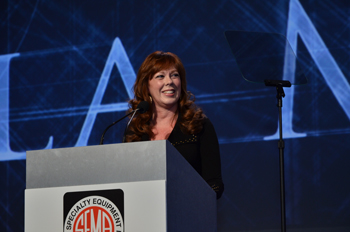 |
Marla Moore
The Lifelong Volunteer
Asked about her persistent commitment to volunteerism and why she has spent so much of her time and energy serving the automotive specialty-equipment industry, Marla Moore answered in typically modest fashion: “Actually, I started volunteering late.”
“I think most people start volunteering with the intent to make new connections in order to boost their career,” she added. “But once you start volunteering, you find that you get back so much more than that. It’s not about your career anymore. It’s more about the people, relationships, the things you learn and making an impact. You see things that need to be done or ways to help improve something that will help our industry and you just do it!
“I’d been in the industry for about 15 years, and I was working with Amy Faulk, who has always been volunteering with SEMA. I was very fortunate to have her as a mentor. She was working on the scholarship auction and said, ‘Hey, you really need to get involved,’ and she made that pathway for me, encouraged me to do it. It was the best thing I have ever done.”
As of today, Moore has been in the industry for more than 35 years. She currently works as the marketing director for Legendary Companies’ (formerly Coker Group) six companies and 10 brands. Moore served on multiple SEMA councils, networks and task forces for 20 years, and she currently serves as chairman of the Emerging Trends & Technology Network (ETTN).
When people speak about Moore, terms such as “outstanding leadership” and “mentorship” are often used freely. Seeing other people succeed is what brings her success.
“Most of my mentors have felt the same way,” Moore continued. “When I was in art school, one of my art teachers said, ‘My job is to make sure that all of you are better artists than I will ever be.’ I took that to heart. Amy Faulk also gives and gives and wants everyone to be the best they can be. Wade Kawasaki believes the same way. He’s all about empowering others. I’ve been very, very lucky in having mentors who believe that to be a good leader means to serve those you’re leading.”
Moore didn’t choose the automotive industry. It was more like it chose her. She was an illustrator and an artist doing ad agency work for Federal Express, and Tropicana when one of her clients, a little company called Auto Shack—now known as Auto Zone—hired her away.
“I’ve never applied for a job in the automotive industry,” Moore said. “I just got brought in. Once I was in, I loved it. The people were so passionate and willing to share their knowledge, you can’t find any more genuine people than in this industry.”
Growing up, Moore remembers her father was always rebuilding a car. “He’d bring home a “barn find”—a ’57 Chevy, a Studebacker, an MG and restore it from the engine to the upholstery—he did it all. Moore’s grandmother would tell her stories about her father when he was 12–14 years old. He would pull an engine apart in the middle of the night and put it back together. He would drive cars that had no seats, and he’d sit on milk cartons and use pliers for steering wheels. “My proudest moment was when I got to bring my dad to the SEMA Show and introduce him to all his heroes, all the men that had invented and built all the parts he had used over the years.”
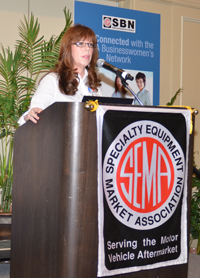 |
Her father was in the Air Force and the family moved around a lot. When he retired after 20 years, he opened an engine repair shop and taught engine building at the local trade school. Because she was the artist in the family, he would take Moore to the track in Lakeland, just outside Memphis, and she would bring her art supplies and paint names and numbers on the sides of the cars for his friends.
“I blame him all the time,” she said. “I’d say, ‘See dad? I wanted to be an artist or fashion designer, and I’m in the car business because you started making me paint race cars.’”
When she was about 18, Moore got a Suzuki 250 from her boyfriend who loved to ride and race.
“I learned to ride, and I would race dirt bikes with the guys,” she said. “I did that for about three years until I tried to jump a ravine and the bike didn’t make it. I loved going fast and catching air! My mom would get mad at me, because I’d come home and I could stand my clothes up, they were so covered in mud.
“This industry has afforded me opportunities to do things most people only dream of from racing Formula Mazda at Laguna Seca, Off-Road Trucks in Las Vegas to the BFG Baja Adventure. I am always up for a new experience.”
It’s impossible to list the extent of her involvement in SEMA committees and task forces, but highlights include serving for five years on the ETTN to refocus the network on engineering and vehicle technology; chairing the Media Trade Conference task force for six years where she was instrumental in naming the Robert E. Petersen Award during her time as a MPMC select committee member; and 12 years with the SEMA Businesswomen’s Network (SBN)—where she pioneered the Gear-Up Girl event and led the SEMA Mustang Build—Powered by Women project.
“The SEMA Mustang Build—Powered by Women changed my life as it did for so many women in our industry. I can’t express the amount of gratitude I feel for every woman who contributed their time, talent and finances to be a part of this historical build. It was a challenge at every turn but the outcome not only produced a bad-ass gorgeous car, but it showcased the immensely talented women in our industry, created lifelong friendships, launched careers and empowered women to step into the limelight.” Moore added, “I was so blessed to be the chairman of the most capable select committee ever, and it took all of us to make it successful!”
She is a SEMA Political Action Committee President’s Club member and currently serves on the board of directors of the Austin Hatcher Foundation for Pediatric Cancer, a SEMA Cares charity. She was named SEMA’s 2012 Person of the Year, 2013 SBN Woman of the Year and, in 2018, was named to the MPMC Hall of Fame.
With so many accolades highlighting her many accomplishments, Moore reflected on her induction into the SEMA Hall of Fame.
“When Chris Kersting called and told me, I said, ‘Why me?’ I feel like an impostor compared to all the people I admire in the Hall of Fame,” Moore said. “The most exciting part about being in the Hall of Fame is that I am now a permanent member of SEMA, and I get to come to every SEMA Show from now on—whether I’m working in the industry or retired. To always belong, that is the best thing.”
With all her efforts put forth volunteering and making the industry a better place, Moore was asked what inspires her.
“I’m a creative problem solver with a desire to constantly improve,” she said. “I’m inspired by other people’s passions and desire to succeed, and it motivates me to want to help. I now have connections and experience and all those things that can help move projects forward or make other people’s dreams come true. Impacting our industry for the better and encouraging the people in it—that’s my thing.”


